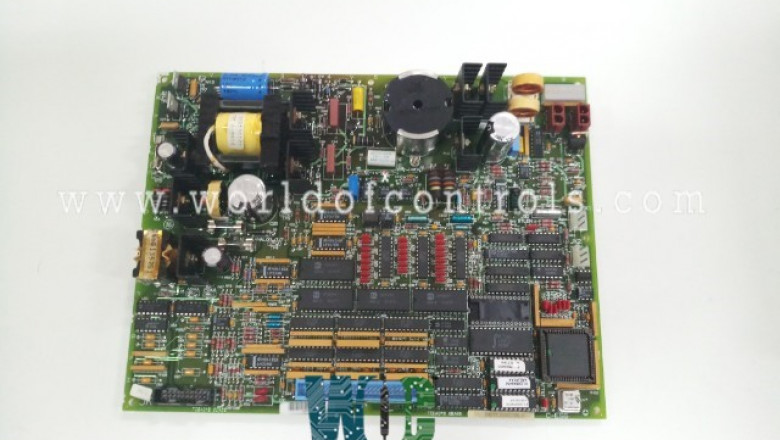views
In modern industrial automation systems—especially those involving gas and steam turbines—power reliability and seamless communication are two of the most crucial elements. Any lapse in either can bring a high-performance operation to a halt. To ensure continuous control and safety, control systems rely on highly integrated components like DS200UPLAG1B - Power Supply/LAN Interface Board
These boards, such as the DS200UPLAG1B, serve a dual purpose. They regulate and distribute power to various control subsystems while simultaneously facilitating network communication between modules. These two functions, bundled into a single board, are foundational to stable, responsive, and protected operations in turbine control environments.
II. What Does a Power Supply/LAN Interface Board Do?
A Power Supply/LAN Interface Board acts as both the heart and the nervous system of a control panel. On the one hand, it takes in power from upstream sources and distributes regulated voltages (like 5V, 12V, or 24V) to multiple modules or racks. On the other, it manages LAN communication pathways, allowing the system’s brains—like CPUs, I/O processors, and HMIs—to coordinate effectively.
In control systems like the GE Mark V and Mark VI, this board:
-
Ensures stable and filtered power delivery to processing units.
-
Manages LAN data exchange between local and remote modules.
-
Provides signal conditioning and electrical isolation for safety.
-
Enables diagnostic communication with service tools or monitoring systems.
Its ability to handle both power and data means that it plays a pivotal role in maintaining operational integrity across the entire automation network.
III. Why Power Integrity Matters in Industrial Systems
Turbine control systems demand clean, continuous power. Even minor fluctuations in voltage or power quality can cause:
-
Unexpected system resets.
-
Sensor misreads.
-
Output signal corruption.
-
Damage to sensitive semiconductor components.
That’s why boards like DS200UPLAG1B are equipped with:
-
Voltage regulation circuits to maintain consistent output.
-
Surge protection to guard against transient spikes.
-
EMI/RFI filtering to minimize electrical noise.
Without such protections, even a small power dip could trigger false alarms or cause a turbine controller to shut down unexpectedly—leading to costly downtime or even damage.
IV. LAN Interface Role in Control System Communication
In the industrial world, LAN communication goes beyond office-style Ethernet. It’s engineered for speed, redundancy, and determinism—ensuring that commands, status updates, and safety signals are delivered on time, every time.
The LAN interface portion of the board is responsible for:
-
Facilitating real-time communication between CPUs, operator stations, and I/O modules.
-
Managing protocols like ARCNET, Modbus, or proprietary GE systems.
-
Enabling the system to sync distributed operations like valve control, fuel flow regulation, or vibration monitoring.
-
Supporting diagnostic tools during startup, fault analysis, or maintenance routines.
This communication capability is essential for systems that rely on instant reaction times—where a millisecond delay can make the difference between a safe shutdown and a dangerous overspeed condition.
V. Features That Set This Board Apart
Power Supply/LAN Interface Boards like the DS200UPLAG1B are designed with several advanced features that ensure performance, safety, and long-term reliability in critical environments.
Key features include:
-
Self-diagnostics: Built-in error detection mechanisms allow early fault identification, preventing failures before they impact operations.
-
Redundant circuit paths: Designed for high-reliability systems where single-point failure is unacceptable.
-
Isolated output channels: Prevent electrical feedback from damaging sensitive components.
-
Signal conditioning: Ensures clean, interpretable signals across communication lines.
-
Status LEDs and jumpers: Provide real-time visual feedback and configurable settings for ease of use and maintenance.
These features collectively make the board well-suited to operate in harsh industrial conditions where voltage disturbances, noise, and vibration are common.
VI. Common Use Cases in Turbine and Process Plants
The DS200UPLAG1B and similar boards are typically found in GE control systems, particularly in Mark V and Mark VI turbine control platforms. They serve as a bridge between raw power input and the precise communication needs of sophisticated industrial machinery.
Common deployment areas include:
-
Gas and steam turbine control panels.
-
Boiler management systems.
-
Industrial process automation involving multiple interconnected control modules.
During turbine startup, for instance, this board ensures that the main processor, I/O units, and user interfaces receive stable power and synchronized communication, which is critical to execute safe ramp-up sequences. Similarly, during fault conditions, the board allows diagnostic data to be logged and retrieved quickly—enabling engineers to isolate issues without triggering unnecessary shutdowns.
VII. Maintenance, Troubleshooting & Best Practices
Because of its dual role, maintaining the board requires a clear understanding of both power and communication systems.
Signs the board may be failing:
-
Intermittent LAN communication loss.
-
Frequent system resets or undervoltage alarms.
-
Unresponsive modules or controller faults during power cycles.
Maintenance and troubleshooting tips:
-
Check for blown fuses or loose connectors.
-
Use onboard LEDs and test points to monitor voltage levels.
-
Ensure firmware compatibility if replacing with a different revision.
-
Perform regular visual inspections for heat damage, corrosion, or dust buildup.
-
Use proper grounding and surge protection in the installation environment.
Replacing the board should always be done with system power down and anti-static procedures in place. After installation, a full system diagnostic is recommended to verify both power and communication integrity.
VIII. Conclusion
The DS200UPLAG1B Power Supply/LAN Interface Board exemplifies how critical components behind the scenes keep complex turbine and process control systems running smoothly. By managing both regulated power distribution and real-time LAN communication, this board serves as the backbone of many high-stakes operations.
Whether during startup, full-load operation, or diagnostics, having a stable and intelligent interface for power and data means greater reliability, fewer faults, and better system performance. It’s one of those components you don’t often see—but everything else depends on it working flawlessly.
Read Also- DS200TCEAG2BTF - Emergency Overspeed Board














Comments
0 comment